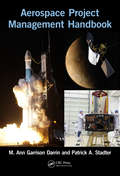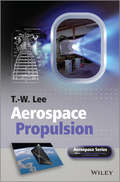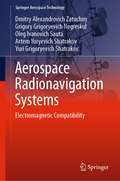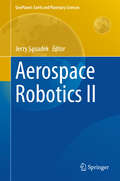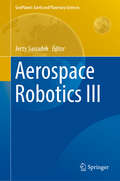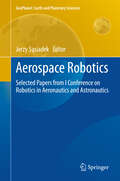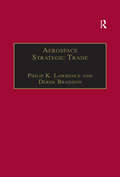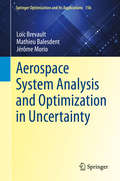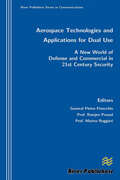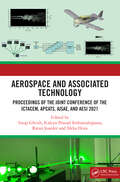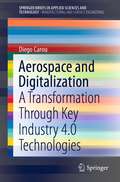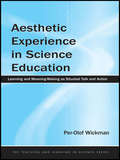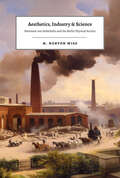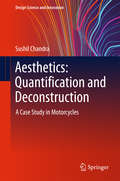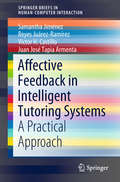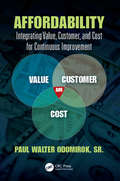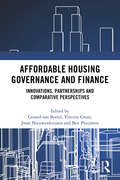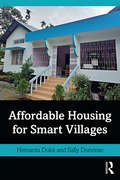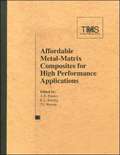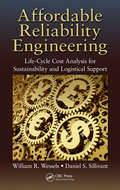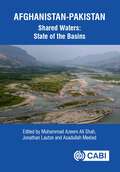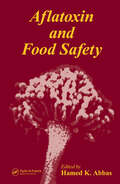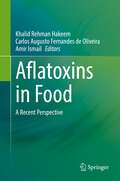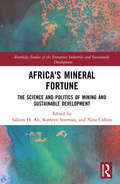- Table View
- List View
Aerospace Project Management Handbook
by M. Darrin Patrick StadterThe Aerospace Project Management Handbook focuses on space systems, exploring intricacies rarely seen in land-based projects. These range from additional compliance requirements from Earned Value Management requirements and regulations (ESA, NASA, FAA), to criticality and risk factors for systems where repair is impossible. Aerospace project management has become a pathway for success in harsh space environments, as the Handbook demonstrates. With chapters written by experts, this comprehensive book offers a step-by-step approach emphasizing the applied techniques and tools, and is a prime resource for program managers, technical leads, systems engineers, and principle payload leads.
Aerospace Propulsion
by T. W. LeeAerospace propulsion devices embody some of the most advanced technologies, ranging from materials, fluid control, and heat transfer and combustion. In order to maximize the performance, sophisticated testing and computer simulation tools are developed and used. Aerospace Propulsion comprehensively covers the mechanics and thermal-fluid aspects of aerospace propulsion, starting from the fundamental principles, and covering applications to gas-turbine and space propulsion (rocket) systems. It presents modern analytical methods using MATLAB and other advanced software and includes essential elements of both gas-turbine and rocket propulsion systems. Gas turbine coverage includes thermodynamic analysis, turbine components, diffusers, compressors, turbines, nozzles, compressor-turbine matching, combustors and afterburners. Rocket coverage includes chemical rockets, electrical rockets, nuclear and solar sail.Key features:Both gas-turbine and rocket propulsion covered in a single volumePresents modern analytical methods and examplesCombines fundamentals and applications, including space applicationsAccompanied by a website containing MATLAB examples, problem sets and solutionsAerospace Propulsion is a comprehensive textbook for senior undergraduate graduate and aerospace propulsion courses, and is also an excellent reference for researchers and practicing engineers working in this area.
Aerospace Radionavigation Systems: Electromagnetic Compatibility (Springer Aerospace Technology)
by Dmitry Alexandrovich Zatuchny Yuri Grigoryevich Shatrakov Grigory Grigoryevich Negreskul Oleg Ivanovich Sauta Artem Yuryevich ShatrakovThis book presents concepts for radio engineers to ensure electromagnetic compatibility based on the methodological approaches to reduce the probability of failures of radio equipment and improve the flight safety of complex aerospace systems. The book deals with issues related to methods for assessing the electromagnetic compatibility of integrated ground and on-board complexes, methods for obtaining information about unintentional interference, the theory of predicting unintentional interference, experimental studies of the characteristics that determine electromagnetic compatibility, methods for calculating reference systems, the influence of the method of generating the output signals of the transmitting path on the relative level of spurious radiation, electromagnetic compatibility of ultrahigh-frequency devices with phase modulation, with the features of industrial noise, with the calculation of electromagnetic fields scattered elements of the airframe, with direction finding errors caused by the scattering of electromagnetic fields by elements of the airframe, with the evaluation of isolation between antennas in the presence of an electromagnetic screen, solving problems of electromagnetic compatibility of antenna devices with the model electromagnetic interference radio systems, calculation of electromagnetic compatibility of specific navigation systems, with the provision of electromagnetic compatibility in civil aviation, taking into account modern requirements.
Aerospace Robotics II (GeoPlanet: Earth and Planetary Sciences)
by Jerzy SąsiadekThis book presents a selection of conference contributions from CARO'13 (Conference on Aerospace Robotics), which was held in Warsaw from July 1 to 3, 2013. It presents the most important and crucial problems of space automation in context of future exploration programs. These programs could involve such issues as space situational awareness program, planetary protection, exploitation of minerals, assembly, manufacturing, and search for new habitable location for next human generations. The future exploration of Space and related activities will involve robots. In particular, new autonomous robots need to be developed with high degree of intelligence. Such robots would make space exploration possible but also they would make space automation an important factor in variety of activities related to Space.
Aerospace Robotics III (GeoPlanet: Earth and Planetary Sciences)
by Jerzy SasiadekThis book includes extended versions of original works on aerospace robotics presented at the Conference on Aerospace Robotics (CARO) in Warsaw. It presents recent advances in aerospace robotics, such as manipulators, which are widely used in space for orbital operations, for example, the Mobile Servicing System on the International Space Station and the Shuttle Remote Manipulator System. Such manipulators are operated by astronauts and mounted on large platforms, making the influence of manipulator motion on the state of the platform insignificant. Application of manipulators for capture maneuvers in unmanned On-Orbit Servicing or Active Debris Removal missions requires reliable control algorithms that take into account the free-floating nature of the manipulator-equipped spacecraft. As such the book presents possibilities for using space manipulators for exploration and a variety of space operations. Further, it discusses new methods for the control of autonomous unmanned aerial vehicles (UAV) using vision systems and sensor fusion methodologies. Such autonomous flying vehicles could be used for materials deliveries and emergencies, as well as surveying and servicing.
Aerospace Robotics: Selected Papers from I Conference on Robotics in Aeronautics and Astronautics (GeoPlanet: Earth and Planetary Sciences)
by Jerzy SąsiadekThis book presents the most important and crucial problems of space automation in context of future exploration programs. These programs could involve such issues as space situational awareness program, planetary protection, exploitation of minerals, assembly, manufacturing, and search for new habitable location for next human generations. The future exploration of Space and related activities will involve robots. In particular, new autonomous robots need to be developed with high degree of intelligence. Such robots would make space exploration possible but also they would make space automation an important factor in variety of activities related to Space.
Aerospace Strategic Trade: How the US Subsidizes the Large Commercial Aircraft Industry
by Philip K. Lawrence Derek BraddonThe U.S. economy is generally considered to run on free market or laissez faire principles, implying that U.S. policy makers do not provide government support for industrial or commercial sectors. While mostly true, it is not the case with strategic industries, such as aerospace. Support for the aerospace sector has been viewed as essential, because aerospace technologies have been the material backbone of U.S. security systems. But American historic dominance in commercial aerospace, and particularly the large commercial aircraft sector, arose on the back of defence technology paid for by the US government. Aerospace Strategic Trade analyses the subsidy of the U.S. large commercial aircraft (LCA) industry and redefines the terms of the Airbus/Boeing subsidy debate. This is achieved by tracking the benefits to Boeing, of the Research and Technology contracts granted by the DoD and NASA. The book is characterized by a new level of methodological precision in the database upon which the factual claims rest and the analysis derives from an exhaustive search of U.S. public databases and also data on federal R&D contracts, obtained under the Freedom of Information Act (FOIA) in the USA. The overall analysis brings together these two approaches and provides a balanced and highly informative account of U.S. federal funding of the American large commercial aircraft sector. This book is of interest to academics, industrialists and government officials concerned with the aerospace industry, to managers and executives in the aerospace industry.
Aerospace System Analysis and Optimization in Uncertainty (Springer Optimization and Its Applications #156)
by Loïc Brevault Mathieu Balesdent Jérôme MorioSpotlighting the field of Multidisciplinary Design Optimization (MDO), this book illustrates and implements state-of-the-art methodologies within the complex process of aerospace system design under uncertainties. The book provides approaches to integrating a multitude of components and constraints with the ultimate goal of reducing design cycles. Insights on a vast assortment of problems are provided, including discipline modeling, sensitivity analysis, uncertainty propagation, reliability analysis, and global multidisciplinary optimization. The extensive range of topics covered include areas of current open research. This Work is destined to become a fundamental reference for aerospace systems engineers, researchers, as well as for practitioners and engineers working in areas of optimization and uncertainty. Part I is largely comprised of fundamentals. Part II presents methodologies for single discipline problems with a review of existing uncertainty propagation, reliability analysis, and optimization techniques. Part III is dedicated to the uncertainty-based MDO and related issues. Part IV deals with three MDO related issues: the multifidelity, the multi-objective optimization and the mixed continuous/discrete optimization and Part V is devoted to test cases for aerospace vehicle design.
Aerospace Technologies and Applications for Dual Use
by Ramjee Prasad Giacinto Losquadro Hugh Griffiths Marina Ruggieri S. Greco Alexander Soucek Albena Mihovska General Pietro Finocchio Pietro Finocchio Giuseppe Morsillo Mario L. Cosmo Paul E. Gartz Gerardo Lancia G. C. Grasso Enrico Saggese S. Venturi P. Massafra K. P. Doerpelkus Carlo Alberto Penazzi Renzo Meschini Armando Buccheri Marco Tommasi Giovanni Guidotti Nunzio Cocco Marina Grossi Daniele Mortari Carlo Des Dorides Mario Ciampini S. Vetrella L. Verde U. Ciniglio F. Corraro Andrea De Martino Sergio Attilio Jesi Volker Liebig Giuseppe Veredice Ole Mørk Lauridsen L. Pasquali Massimo Capaldo Vittorio Dainelli Cosimo La Rocca Alexander Mager Tiziano Sassorossi S. Arenaccio G. Chiassarini R. Loforti F. Petrosino A. Vernucci Claudio De Bellis Michel Feuga Elisa Tonello Domenico D'Angelo Mesut CicekerThe events occurred in the last years have shown how the threat related to both intentional and natural disasters could bring the civil and the military worlds closer in the conceivement and deployment of countermeasures as well as in the identification of effective strategies for enhancing the Planet safety and security. In this frame, the concept of dual use ? the set of technologies and applications that can be exploited for both civil and military purposes - becomes a key-topic. In addition, the aerospace is a strategic building block in the deployment of a network centric environment that aims at the global protection of the mankind. Aerospace is also a natural environment for dual use: many of the related enabling technologies have been first developed for the military world and then applied to civil ? including commercial - purposes.On September 12-14, 2007 an International Symposium has been held in Roma, Italy, joining the dual use approach with the aerospace technology: the international community has been gathered around the key-topic: aerospace technologies and applications for dual use. The event has called experts and operators from the military and civil community, belonging to industry, scientific and governmental institutions. The common aim was an effective convergence between the available and perspected technologies for the civil and military worlds as well as the conceivement of applications that can take the maximum benefit from the dual approach, optimizing the available economic resources. The Symposium has included invited-only contributions and an industrial panel. The main results of the Symposium, derived from key-note speeches, invited lectures, panel discussions and conclusions have created the starting material to develop this Edited Book.
Aerospace and Associated Technology: Proceedings of the Joint Conference of ICTACEM 2021, APCATS 2021, AJSAE 2021 and AeSI 2021
by Anup Ghosh Kalyan Prasad Sinhamahapatra Ratan Joarder Sikha HotaThe International Conference on Theoretical Applied Computational and Experimental Mechanics is organized every three years by the Department of Aerospace Engineering IIT Kharagpur. The conference is devoted to providing a platform for scientists and engineers to exchange their views on the latest developments in Mechanics since 1998. ICTACEM Conference is aimed at bringing together academics and researchers working in various disciplines of mechanics to exchange views as well as to share knowledge between people from different parts of the globe. The 8th ICTACEM was held from December 20-22, 2021, at the Indian Institute of Technology, Kharagpur.
Aerospace and Digitalization: A Transformation Through Key Industry 4.0 Technologies (SpringerBriefs in Applied Sciences and Technology)
by Diego CarouThis book reports a comprehensive study on the Industry 4.0 technologies focused on the aerospace sector, presenting a blueprint of the sector and the background of the key technologies. The author describes the adoption of some of these technologies by some of the major aerospace companies and organizations.
Aesthetic Experience in Science Education: Learning and Meaning-Making as Situated Talk and Action (Teaching and Learning in Science Series)
by Per-Olof WickmanThis book examines the role of aesthetic experience in learning science and in science education from the perspective of knowledge as action and language use. The theoretical underpinnings are based on the writings of John Dewey and Ludwig Wittgenstein. In their spirit aesthetics is examined as it appears in the lives of people and how it relates to the activities in which they are involved.Centered around an empirical analysis of how students and their teachers use aesthetic language and acts during laboratory and field work, the book demonstrates that aesthetics is something that is constantly talked about in science class and that these aesthetic experiences are intimately involved in learning science. These empirical findings are related to current debates about the relation between aesthetics and science, and about motivation, participation, learning and socio-cultural issues in science education. This book features:*an empirical demonstration of the importance and specific roles of aesthetic experiences in learning science;*a novel contribution to the current debate on how to understand motivation, participation and learning; and*a new methodology of studying learning in action.Part I sketches out the theoretical concepts of Wickman's practical epistemology analysis of the fundamental role of aesthetics in science and science education. Part II develops these concepts through an analysis of the use of aesthetic judgments when students and teachers are talking in university science classes. Part III sums up the general implications of the theoretical underpinnings and empirical findings for teaching and learning science. Here Wickman expands the findings of his study beyond the university setting to K-8 school science, and explicates what it would mean to make science education more aesthetically meaningful.Wickman's conclusions deal to a large extent with aesthetic experience as individual transformation and with people's prospects for participation in an activity such as science education. These conclusions have significance beyond science teaching and learning that should be of concern to educators generally. This book is intended for educational researchers, graduate students, and teacher educators in science education internationally, as well as those interested in aesthetics, philosophy of education, discourse analysis, socio-cultural issues, motivation, learning and meaning-making more generally.
Aesthetics, Industry, and Science: Hermann von Helmholtz and the Berlin Physical Society
by M. Norton WiseOn January 5, 1845, the Prussian cultural minister received a request by a group of six young men to form a new Physical Society in Berlin. In fields from thermodynamics, mechanics, and electromagnetism to animal electricity, ophthalmology, and psychophysics, members of this small but growing group—which soon included Emil Du Bois-Reymond, Ernst Brücke, Werner Siemens, and Hermann von Helmholtz—established leading positions in what only thirty years later had become a new landscape of natural science. How was this possible? How could a bunch of twenty-somethings succeed in seizing the future? In Aesthetics, Industry, and Science M. Norton Wise answers these questions not simply from a technical perspective of theories and practices but with a broader cultural view of what was happening in Berlin at the time. He emphasizes in particular how rapid industrial development, military modernization, and the neoclassical aesthetics of contemporary art informed the ways in which these young men thought. Wise argues that aesthetic sensibility and material aspiration in this period were intimately linked, and he uses these two themes for a final reappraisal of Helmholtz’s early work. Anyone interested in modern German cultural history, or the history of nineteenth-century German science, will be drawn to this landmark book.
Aesthetics: A Case Study in Motorcycles (Design Science and Innovation)
by Sushil ChandraThis book addresses a perennial challenge for product planners and designers alike: how to objectively specify and quantify the aesthetics of products. It provides automotive product planners with a framework for the grammar of aesthetics and a tool for quantifying the aesthetics of an intended product. Further, it equips styling designers with a tool for connecting engineering and aesthetics. Given the author's extensive experience in motorcycle design, the motorcycle has been chosen as the frame of reference for automobiles. Specifically in the field of automobile design, where engineering and aesthetics go hand in hand, it also becomes important to clearly and objectively define the relationship between engineering design and aesthetics. Accordingly, this book (1) clearly establishes the objective parameters of aesthetics, (2) puts forward a method for quantifying aesthetics, (3) identifies the engineering design parameters affecting aesthetics, and (4) determines the relationship between parameters of aesthetics and engineering design. As such, it offers a useful guide not only for design professionals, but also for students and researchers of design.
Affective Feedback in Intelligent Tutoring Systems: A Practical Approach (Human–Computer Interaction Series)
by Samantha Jiménez Reyes Juárez-Ramírez Victor H. Castillo Juan José Tapia ArmentaAffective components are as important as cognitive components in tutoring assisted learning process. Feedback from tutors is essential in keeping students motivated. Affectivity and motivation are also significant in computer-based tutoring systems. However, several educational frameworks do not include this kind of interaction between students and tutoring systems. In those cases, the students learning interest and motivation to learn could be negatively affected, and student profits from the system could be impoverished. This is why tutoring systems need to provide direct and affective interaction with students; it can encourage them and increase the motivation to learn. This book introduces a broad range of topics in affective learning in computer-based systems. The text offers a deep conceptual background, covering relevant concepts of affectivity, feedback and motivational components in learning environments. It describes the design of a proposed model for providing affective feedback, the mathematical validation of the conceptual model and its implementation. Moreover, it presents an analysis of the impact of the affective feedback on student motivation to learn. Finally, the book offers research perspectives of the impact and applicability of the affective feedback in computer-based tutoring environments. Affective Feedback in Intelligent Tutoring Systems can be used by human tutors who want to include motivational and affective elements in the learning process, researchers in Human-Computer Interaction and Education and by software developers who want to develop learning systems using these elements.
Affordability: Integrating Value, Customer, and Cost for Continuous Improvement (Continuous Improvement Series)
by Paul Walter Odomirok, Sr.Affordability is a new concept that allows the implementation of Continuous Improvement for any organization. It encapsulates contemporary methods that improve product and service profitability, increases market share, value, speed, quality and capability, and cuts down on cost. This new method addresses the needs of growing, improving, and sustaining an organization. It provides a framework and foundation for launching improvement initiatives, deploying continuous improvement, and maintaining the cultural habits and behaviors required to continue such efforts. Case studies from a variety of industries, businesses, and institutions are provided.
Affordable Housing Governance and Finance: Innovations, partnerships and comparative perspectives
by Vincent Gruis Joost Nieuwenhuijzen Ben Pluijmers Gerard BortelThere is a large shortage of affordable housing across Europe. In high‐demand urban areas housing shortages lead to unaffordable prices for many target groups. This book explores innovations to support a sufficient supply of affordable and sustainable rental housing. Affordable housing is increasingly developed, financed and managed by a mix of market, state, third sector and community actors. Recent decades in large parts of the Western world have consecutively shown state-dominated, non-profit housing sectors, an increased role for market forces and the private sector, and the rise of initiatives by citizens and local communities. The variety of hybrid governance and finance arrangements is predicted to increase further, leading to new affordable housing delivery and management models. This book explores these innovations, with a focus on developments across Europe, and comparative chapters from the USA and Australia. The book presents new thinking in collaborative housing, co-production and accompanying finance mechanisms in order to support the quantity and the quality of affordable rental housing. Combining academic robustness with practical relevance, chapters are written by renowned housing researchers in collaboration with practitioners from the housing sector. The book not only presents, compares and contrasts affordable housing solutions, but also explores the transferability of innovations to other countries. The book is essential reading for researchers and professionals in housing, social policy, urban planning and finance.
Affordable Housing for Smart Villages
by Sally Donovan Hemanta DoloiThis book initiates a fresh discussion of affordability in rural housing set in the context of the rapidly shifting balance between rural and urban populations. It conceptualises affordability in rural housing along a spectrum that is interlaced with cultural and social values integral to rural livelihoods at both personal and community level. Developed around four intersecting themes: explaining houses and housing in rural settings; exploring affordability in the context of aspirations and vulnerability; rural development agendas involving housing and communities; and construction for resilience in rural communities, the book provides an overview of some of the little understood and sometimes counter-intuitive best practices on rural affordability and affordable housing that have emerged in developing economies over the last thirty years. Drawing on practice-based evidence this book presents innovative ideas for harnessing rural potential, and empowering rural communities with added affordability and progressive development in the context of housing and improved living standards. For a student aspiring to work in rural areas in developing countries it is an introduction to and map of some key solutions around the critical area of affordable housing For the rural development professional, it provides a map of a territory they rarely see because they are absorbed in a particular rural area or project For the academic looking to expand their activities into rural areas, especially in rural housing, it provides a handy introduction to a body of knowledge serving 47% of the world's population, and how this differs from urban practice For the policy makers, it provides a map for understanding the dynamics around rural affordability, growth potential and community aspirations helping them to devise appropriate intervention programs on rural housing and development
Affordable Housing in the United States
by Gregg Colburn Rebecca J WalterAffordable Housing in the United States addresses the issue of affordability of housing, or the lack thereof, going beyond conventional policy discussions to consider fundamental questions such as: What makes housing affordable and for whom is it affordable? What are the consequences of a lack of affordable housing? How is affordable housing created? And what steps can be taken to ensure all people have access to affordable housing?With the understanding that different households face different challenges, the book begins by breaking down the variables relevant to the study of affordable housing, including housing costs, household income, geographic location, and market forces, to help readers understand and quantify affordability at the individual and societal level. Part II examines the consequences of unaffordable housing, highlighting racial inequities in housing access and affordability, and multiple forms of housing precarity including eviction and homelessness. Part III explores the entities involved in providing affordable housing such as local and federal governments, regulatory agencies, non-profit organizations, and for-profit developers. In Part IV, case studies from US cities demonstrate the complex web of organizations, policies, and market conditions that influence housing affordability, revealing substantial regional variations in access and policy response. Part V proposes a future roadmap and outlines four potential states with radically different outcomes for the affordable housing system in the United States.An ideal book for graduate and undergraduate courses in economics, public policy, real estate finance and development, sociology, and urban planning, this title will also be of value to professionals and policymakers seeking to understand and improve housing affordability and access.
Affordable Metal Matrix Composites for High Performance Applications II
by Sandeep R. Shah John Lewandowski Kevin L. Kendig Awadh B. PandeyThis book will include papers on recent research carried out in the field of metal-matrix composites (MMCs). Processing, microstructure, and mechanical properties of MMCs and unreinforced matrix alloys will be covered with a focus on aluminum, titanium, nickel, and copper MMCs. Those involved in the research of MMCs and unreinforced alloys, particularly in aerospace, space, and automotive materials research, will find this volume indispensible.From Materials Science & Technology 2003 to be held in Chicago, Illinois, November 9-12, 2003.
Affordable Reliability Engineering: Life-Cycle Cost Analysis for Sustainability & Logistical Support
by William R. Wessels Daniel SillivantHow Can Reliability Analysis Impact Your Company's Bottom Line?While reliability investigations can be expensive, they can also add value to a product that far exceeds its cost. Affordable Reliability Engineering: Life-Cycle Cost Analysis for Sustainability & Logistical Support shows readers how to achieve the best cost for design develo
Afghanistan-Pakistan Shared Waters: State of the Basins
by Arif Anwar Shakeel Hayat Alias Wardak Fazilda Nabeel Hassaan Furqan Inayatullah Jan Karthikeyan Matheswaran Marie-Charlotte Buisson Muhammad Shahid Iqbal Muhammad Tousif Bhatti Muhammad Zia Hashmi Mujib Ahmad Azizi Paul Pavelic Taimoor AkhtarThere is currently no water cooperation between Afghanistan and Pakistan. Of the nine rivers that flow across the border, none possess a formal agreement or mechanism to manage shared water resources. Further, there is very little information available about the status of environment, hydrology and water resources management for these river basins that could be used as a starting point for dialogues on transboundary water coordination. This State of the Basins book co-develops an overview of the three most important river basins, in collaboration with international experts and water professionals from Afghanistan and Pakistan. It covers water resources, land resources, ecological health, environment, climate change, and the social and economic conditions for sustainable management of these precious resources. It will inform decision making within the two countries, and begin to establish benefits that can accrue from more active collaboration on these shared waters. This book: · Focuses on portions of the Indus shared by Afghanistan and Pakistan. · Features extensive engagement and co-development with Afghan and Pakistani professionals. · Is the first book on the shared waters in the Indus, developed in the context of regional realities associated with post-August 2021 Taliban takeover. The book is aimed at students and researchers in water rights and resources, and government decision makers, private sector investors, donors, intermediary organizations that work directly with farmers, researchers and students. It is a reference book for graduate students and researchers working on these basins, and on transboundary river basin management in Asia and beyond.
Aflatoxin and Food Safety
by Hamed K. AbbasAflatoxins are responsible for damaging up to 25% of the world's food crops, resulting in large economic losses in developed countries and human and animal disease in under-developed ones. In addition to aflatoxins, the presence of other mycotoxins, particularly fumonisins, brings additional concerns about the safety of food and field supplies. The
Aflatoxins in Food: A Recent Perspective
by Khalid Rehman Hakeem Carlos A. F. Oliveira Amir IsmailMycotoxins are the metabolites of fungus and are reported to contaminate nearly 25% of the food produced worldwide. The mycotoxins of most significance are the aflatoxins due to their severe health implications and their prevalence in food commodities on a larger scale. Aflatoxins are produced by certain species of fungi the most prominent among which are Aspergillus flavus, A. parasiticus and A. nominous. Food commodities of African and South Asian countries are especially reported to have aflatoxins well beyond the allowable limits but due to the global trade of food commodities developed countries are also prone towards the perils of aflatoxins. Moreover, climate changes may have a substantial impact on the distribution and global prevalence of aflatoxins in the near future.The International Agency for Research on Cancer (IARC) has classified the aflatoxins as group 1 category carcinogen. Aflatoxins are also reported as teratogenic, mutagenic, growth retardant, immunosuppressant and may also cause nervous system and reproductive system disorders. Preventive approaches involving good manufacturing from “farm to fork” are the major focus of the current food industry.The aim of our book is to provide readers with the most recent data and up-to-date studies from aflatoxins research, with specific focuses on (i) the impact of aflatoxins on human health, (ii) new approaches by the researchers from different parts of the world to degrade aflatoxins and (iii) potential preventive approaches that can significantly lessen the burden of aflatoxins in food products
Africa's Mineral Fortune: The Science and Politics of Mining and Sustainable Development (Routledge Studies of the Extractive Industries and Sustainable Development)
by Saleem H. Ali Kathryn Sturman Nina CollinsFor too long Africa's mineral fortune has been lamented as a resource curse that has led to conflict rather than development for much of the continent. Yet times are changing and the opportunities to bring technical expertise on modern mining alongside appropriate governance mechanisms for social development are becoming more accessible in Africa. This book synthesizes perspectives from multiple disciplines to address Africa’s development goals in relation to its mineral resources. The authors cover ways of addressing a range of policy challenges, environmental concerns, and public health impacts and also consider the role of globalization within the extractive industries. Academic research is coupled with key field vignettes from practitioners exemplifying case studies throughout. The book summarizes the challenges of natural resource governance, suggesting ways in which mining can be more effectively managed in Africa. By providing an analytical framework it highlights the essential intersection between natural and social sciences, central to efficient and effective harnessing of the potential for minerals and mining to be a contributor to positive development in Africa. It will be of interest to policy makers, industry professionals, and researchers in the extractive industries, as well as to the broader development community.
